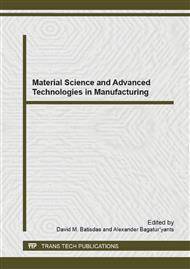[1]
Safa Karaman and Ahmed Kayacier: LWT - Food Science and Technology. Vol. 44 (2011), P. 1717.
Google Scholar
[2]
B. Fang: Introduction to chemical rheology (China TeXtile Publications, Bei Jing 2010).
Google Scholar
[3]
Lee, S and Choi, S.U. S: Application of metallic nanoparticle suspensions in advanced cooling systems ( ASME Publications, 1996).
Google Scholar
[4]
Li Y J, Zhou J E and Tung S: Power Technology. Vol. 196 (2009), P. 89.
Google Scholar
[5]
G. Paul, J. Philip, B. Raj and P.K. Das: Heat Mass Transfer. Vol. 54 (2011), P. 3783.
Google Scholar
[6]
I.M. Mahbubul, R. Saidur and M.A. Amalina: International Journal of Heat and Mass Transfer. Vol. 55 (2012), P. 874.
Google Scholar
[7]
J. Eastman, S. Choi, S Li and W. Yu, L: Appl. Phys. Lett. Vol. 78 (2001), P. 718.
Google Scholar
[8]
H. Zhu, and Y. Yin: Colloid Interface Sci. Vol. 277 (2004), P. 100.
Google Scholar
[9]
D. Wen and Y. Ding: Heat Fluid Flow. Vol. 26 (2005), P. 855.
Google Scholar
[10]
E. Goharshadi, Y. Ding and M. Jorabchi: Ultrason. Sonochem. Vol. 16 (2009), P. 120.
Google Scholar
[11]
Prasher R, Song D and Wang J: Applied Physics Letters. Vol. 89 (2006), P. 133.
Google Scholar
[12]
Ding Y, Hajar A and Wen D: International Journal of Heat and Mass Transfer. Vol. 49 (2006), P. 240.
Google Scholar
[13]
Y. Jin and J. Cao: China society of the 7th annual seminar and particle technology seminar on both sides of the Taiwan straits . Vol. 7 (2010), P. 707 (In Chinese).
Google Scholar
[14]
X. Peng. and X. Yu: Journal of Zhejiang University. Vol. 41 (2007), P. 577 (In Chinese).
Google Scholar
[15]
E.V. Timofeeva, W. Yu and D.M. France: Nanoscale Res. Lett. Vol. 6 (2011), P. 182.
Google Scholar
[16]
J. Zhao, Z. Luo and M Ni: Chinese PHysical Society and IOP Publishing Ltd, Vol. 26 (2009), P. 1 (In Chinese).
Google Scholar
[17]
Y. He, Y. Jin and H. Chen: Heat Mass Transfer. Vol. 50 (2007), P. 2272.
Google Scholar
[18]
Z. Tang, L. Peng and S. Zhang: Chemical Industry and Engineering. Vol. 3 (2012), P. 1 (In Chinese).
Google Scholar
[19]
Aaron J. Schmidt, a Matteo Chiesa and Darius H: American Institute of PHysics, Vol. 92(2008), p.45.
Google Scholar
[20]
N. Siva Shanker, M. Chandra Shekar Reddy and V. V. Basava Rao: International Journal of Engineering Research & Technology (IJERT). Vol. 1 (2012), P. 1.
Google Scholar
[21]
H. Chen, Y. Ding and Y. He: Chem. Phys. Lett. Vol. 444 (2007), P. 333.
Google Scholar
[22]
Y. Li, S. Xu: food science. Vol. 15 (2009), P. 71 (In Chinese).
Google Scholar
[23]
Ruben Mercade´-Prieto and Rachael Allen: AIChE Journal. Vol. 58 (2012), P. 2674.
Google Scholar
[24]
Y. Gu, Z. Xiao: Journal of Shanghai institute of applied technology. Vol. 1 (2011), P. 12 (In Chinese).
Google Scholar
[25]
M. Wang, Z. Xiao: Fine chemical industry. Vol. 9 (2010), P. 874 (In Chinese).
Google Scholar
[26]
S. Ma, Z. Xiao: Food Industry. Vol. 5 (2010), P. 37 (In Chinese).
Google Scholar
[27]
T. Zhang, Z. Xiao and J. Hu: Flavour Fragrance Cosmetics. Vol. 3 (2013), P. 11 (In Chinese).
Google Scholar


